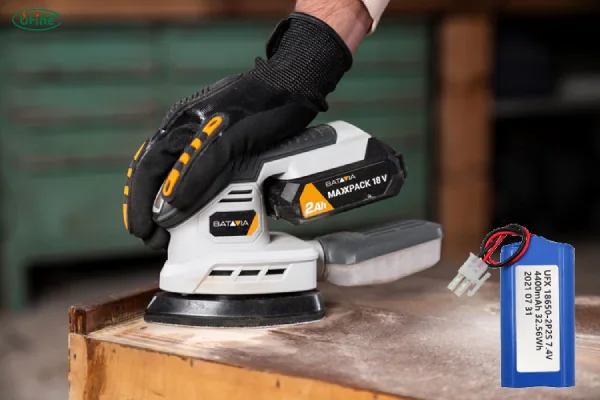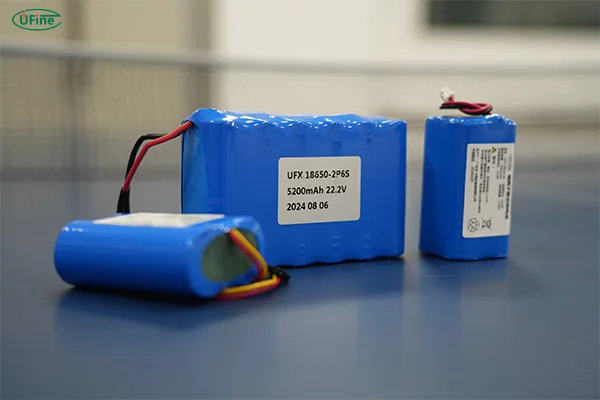
- Part 1. Understanding your sander tool
- Part 2. Corded vs. cordless: why the battery matters
- Part 3. Battery basics: what you need to know
- Part 4. Best battery types for sanders
- Part 5. Voltage and power requirements
- Part 6. Capacity and runtime: How long will it last?
- Part 7. Battery quality and sander performance
- Part 8. Compatibility and fit
- Part 9. Taking care of your sander battery
- Part 10. When to replace your sander battery
- Part 11. Custom battery solutions for sanders
- Part 12. What to look for when buying a sander battery
- Part 13. Final words
- Part 14. FAQs
Choosing the right sander battery is more important than you might think. It doesn’t just power the sander tool—it defines how well it performs, how long it lasts, and how easy it is to use. Whether you’re sanding wood for a DIY project or prepping metal surfaces in a workshop, battery performance can either boost your work—or hold it back.
So how do you pick the right one? In this guide, we’ll walk you through everything you need to know to make a confident decision. We’ll also introduce smart solutions, including how Ufine Battery, a leading Chinese custom lithium battery manufacturer, can help when standard batteries fall short.
Part 1. Understanding your sander tool
Before you can choose a battery, you must understand your sander tool. Different types of sanders demand different kinds of power.
Here are the most common types:
- Orbital sander: Great for smooth surfaces, doesn’t need extreme power.
- Random orbital sander: A bit more powerful; needs steady performance.
- Belt sander: Powerful and fast—requires a high-capacity sander battery.
- Detail sander: Compact and precise, usually fine with small batteries.
Each tool consumes energy differently. Some draw more current; some work in bursts. Understanding this helps match your battery to your tool’s workload.
Part 2. Corded vs. cordless: why the battery matters
Cordless sanders are gaining popularity, and for good reason. No wires mean more freedom, especially in tight spaces. But all that freedom comes at a cost—the battery must deliver reliable power.
Let’s compare cordless and corded options based on:
- Portability: Battery wins, hands down.
- Runtime: Corded tools offer unlimited runtime; battery-powered tools depend on capacity.
- Weight: Batteries add weight—important if you’re sanding for hours.
- Power Consistency: Corded is stable; battery can dip as charge drops.
- Maintenance: Cordless tools need battery upkeep; corded tools don’t.
- Safety: Fewer cords = fewer tripping hazards.
- Convenience: Battery tools win in places without outlets.
Clearly, the sander battery plays a crucial role in cordless tool performance.
Part 3. Battery basics: what you need to know
Battery specifications might seem technical, but don’t worry—we’ll keep it simple.
- Voltage (V): Think of this as power. Higher voltage means more force.
- Capacity (Ah): Stands for ampere-hours. The higher it is, the longer the tool runs.
- Watt-hours (Wh): Voltage × Capacity. This is the actual energy your battery holds.
When you pick a battery, these numbers help you know how long and how well your sander will work.
Part 4. Best battery types for sanders
There are a few common battery chemistries used in sander tools. Each has pros and cons:
Lithium-ion (Li-ion)
- Lightweight
- High energy density
- Fast charging
- Most common in today’s tools
Lithium Iron Phosphate (LiFePO4)
- Longer life cycle
- Stable and safe
- Ideal for high-heat or heavy-duty jobs
- A little heavier, but more reliable
Nickel-Cadmium (NiCd)
- Durable and cheap
- Suffers from memory effect
- Mostly outdated
For most modern sanders, Li-ion or LiFePO4 is the best choice. Ufine Battery offers both and can customize them for your tool.
Part 5. Voltage and power requirements
The voltage of your sander battery should match your tool exactly. Here’s why:
- Too low? The tool might not start or run poorly.
- Too high? You risk overheating or damaging the motor.
Common voltages include 12V, 18V, and 20V. For belt sanders or heavy use, go higher. For light detail sanding, lower voltage is fine.
Part 6. Capacity and runtime: How long will it last?
Let’s say you’re sanding a tabletop. If your battery dies halfway through, that’s frustrating.
That’s why capacity matters:
- 2.0Ah: Good for short, light tasks.
- 4.0Ah–5.0Ah: Balanced option for medium projects.
- 6.0Ah and above: Best for heavy-duty sanding or long sessions.
Remember, more capacity often means a bigger, heavier battery. Find a balance that suits your work.
Part 7. Battery quality and sander performance
Battery quality directly impacts how smooth and powerful your sander tool operates.
Cheap batteries can:
- Drain quickly
- Cause tool overheating
- Deliver inconsistent speed
- Even damage your sander
Always buy from trusted suppliers. Or better yet, opt for custom batteries from Ufine Battery. They specialize in high-performance lithium solutions with strict quality control for safety and reliability.
Part 8. Compatibility and fit
Not all batteries fit all sanders. Some brands make their battery systems exclusive, while others offer compatible packs.
Here’s what to check:
- Physical dimensions
- Connector type
- Charging dock compatibility
- Voltage match
Using the wrong battery can lead to poor contact, short circuits, or even internal damage. When in doubt, ask the supplier—or go custom with Ufine Battery, which can tailor-make batteries to fit your device.
Part 9. Taking care of your sander battery
Good care = longer life. Here’s how to protect your sander battery:
- Charge fully before first use.
- Don’t overcharge or leave it plugged in overnight.
- Store in a cool, dry place.
- Use the recommended charger.
- Don’t drain it to 0% too often.
These habits can add months, even years, to your battery’s usable life.
Part 10. When to replace your sander battery
All batteries wear out eventually. But how do you know when?
Look for these signs:
- Shorter runtime
- Overheating during use
- Won’t hold a charge
- Swelling or physical damage
If you experience any of these, it’s time for a replacement.
Part 11. Custom battery solutions for sanders
Sometimes, the market just doesn’t offer what you need. That’s where custom solutions shine.
Ufine Battery offers:
- Custom voltage and size configurations
- Specialized chemistries like LiFePO4
- Batteries for extreme temperature or high-drain use
- Safe, certified, and tested units
They work directly with clients to design sander batteries that match unique tools or project needs. Whether you’re a tool manufacturer, DIY expert, or industrial buyer, Ufine helps you build better, longer-lasting tools.
Need a custom battery for your sander? Contact Ufine Battery today to get a tailored solution that fits your exact requirements.
Part 12. What to look for when buying a sander battery
Here’s a quick checklist:
- Voltage matches your tool
- Adequate capacity for your project
- Reliable chemistry (Li-ion or LiFePO4)
- Fits your charger and housing
- From a trusted manufacturer
- Includes protection against overcharge and short circuit
If it checks all the boxes, you’re good to go!
Part 13. Final words
The battery is the heart of your sander tool. It powers every stroke, every finish, and every job you take on. Choosing the right sander battery means better performance, longer runtime, and fewer headaches. Whether you’re a pro or a weekend warrior, making the right choice is key.
And if you can’t find exactly what you need? You don’t have to settle. Ufine Battery is here to help with custom, high-quality lithium batteries tailored to your exact sander needs.
Part 14. FAQs
Can I use a higher-capacity battery than recommended?
Yes, as long as the voltage matches. It will run longer.
Is LiFePO4 better than Li-ion for sanders?
In many ways, yes. It’s safer and more stable, though bulkier.
Why does my sander slow down even when the battery isn’t empty?
It could be voltage sag or an aging battery.
Can I use drill batteries in my sander tool?
Only if they are from the same brand and voltage.
How often should I replace my sander battery?
Every 2–3 years on average, depending on use and quality.
Related Tags:
More Articles

A Complete Guide to the Best Batteries for Flashlights
Discover the best batteries for flashlights: alkaline, lithium, NiMH & rechargeable options. Tips for performance and maintenance.
Graphene Battery vs Lithium Battery: Which is Better?
Compare graphene battery vs lithium battery in energy density, charging speed, lifespan, cost, and EV applications. Learn which battery leads in 2025.
What is the Difference Between MCA and CCA on Batteries?
Learn the difference between MCA and CCA batteries. Understand what MCA means, what CCA is, and how to choose the right battery for vehicles or marine engines.
Type of Lithium Battery Voltage
Learn lithium ion battery voltage, nominal voltage, and voltage range. Compare Li-ion, LiPo, LiFePO4, and 18650 voltages, charging, and device compatibility.
Gel Battery vs Lead Acid: A Detailed Comparison
Compare gel and lead-acid batteries: lifespan, cost, charging, DoD, safety, and key use cases. Find the right battery for solar, marine, EV, UPS, and daily use.




